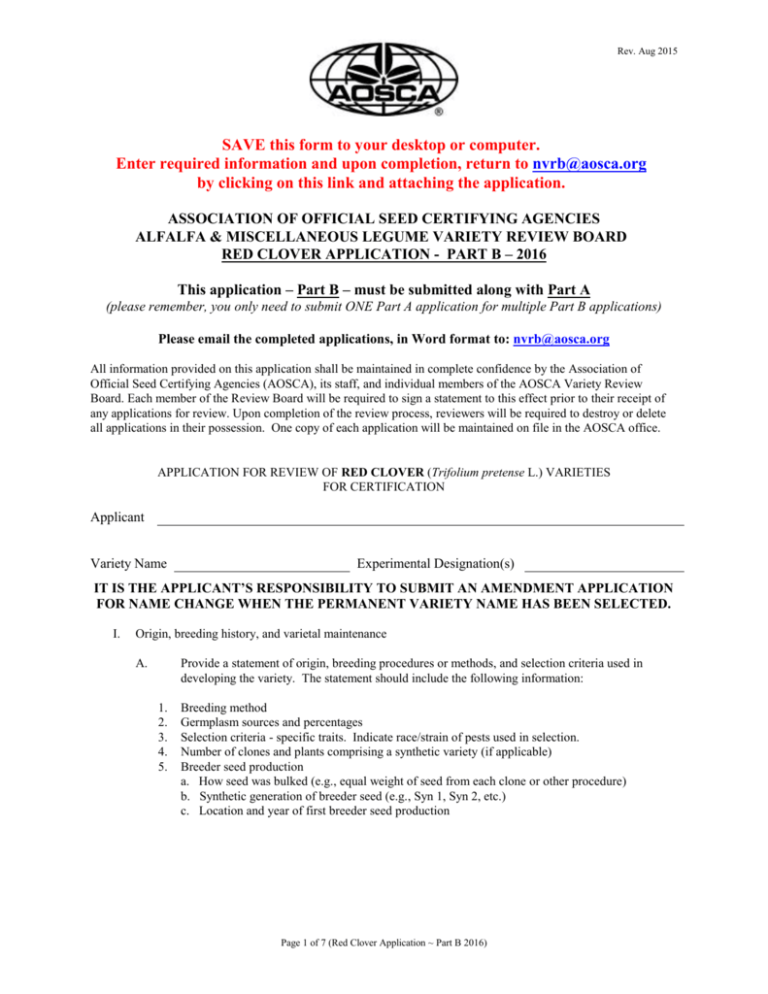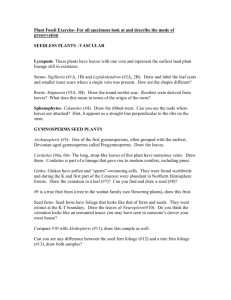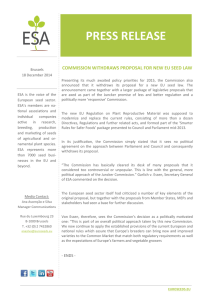State when certified seed may first be offered for sale if this
advertisement

Rev. Aug 2015 SAVE this form to your desktop or computer. Enter required information and upon completion, return to nvrb@aosca.org by clicking on this link and attaching the application. ASSOCIATION OF OFFICIAL SEED CERTIFYING AGENCIES ALFALFA & MISCELLANEOUS LEGUME VARIETY REVIEW BOARD RED CLOVER APPLICATION - PART B – 2016 This application – Part B – must be submitted along with Part A (please remember, you only need to submit ONE Part A application for multiple Part B applications) Please email the completed applications, in Word format to: nvrb@aosca.org All information provided on this application shall be maintained in complete confidence by the Association of Official Seed Certifying Agencies (AOSCA), its staff, and individual members of the AOSCA Variety Review Board. Each member of the Review Board will be required to sign a statement to this effect prior to their receipt of any applications for review. Upon completion of the review process, reviewers will be required to destroy or delete all applications in their possession. One copy of each application will be maintained on file in the AOSCA office. APPLICATION FOR REVIEW OF RED CLOVER (Trifolium pretense L.) VARIETIES FOR CERTIFICATION Applicant Variety Name Experimental Designation(s) IT IS THE APPLICANT’S RESPONSIBILITY TO SUBMIT AN AMENDMENT APPLICATION FOR NAME CHANGE WHEN THE PERMANENT VARIETY NAME HAS BEEN SELECTED. I. Origin, breeding history, and varietal maintenance A. Provide a statement of origin, breeding procedures or methods, and selection criteria used in developing the variety. The statement should include the following information: 1. 2. 3. 4. 5. Breeding method Germplasm sources and percentages Selection criteria - specific traits. Indicate race/strain of pests used in selection. Number of clones and plants comprising a synthetic variety (if applicable) Breeder seed production a. How seed was bulked (e.g., equal weight of seed from each clone or other procedure) b. Synthetic generation of breeder seed (e.g., Syn 1, Syn 2, etc.) c. Location and year of first breeder seed production Page 1 of 7 (Red Clover Application ~ Part B 2016) Rev. Aug 2015 B Seed classes to be used, limitations on age of stand, and areas of production for each class. Seed Class Synthetic Generation Length of Stand Allowed Limitation on Areas for Seed Production Breeder Foundation Registered Certified Only the synthetic generations given for the above seed classes are recognized as representing this variety. No supporting data should be used in this application from Syn. generations other than those for the Breeder, Foundation, Registered, and Certified classes listed here. C. D. Describe procedures for maintaining breeder and foundation seed stock. State the party to be responsible for maintaining seed stock and where seedstock will be maintained. State any additional requirements or limitations necessary to maintain varietal characteristics. II. Testing and adaptation A. List states and areas within states where this variety has been tested for forage yield and/or persistence (Present data from each location in III. A.). B. List: 1. Areas of adaptation, which must be supported by test locations and data. 1 = North Central 2 = East Central 3= Southeast 4 = Southwest 5 = Moderately Winterhardy Intermountain 6 = Winterhardy Intermountain 7 = Great Plains 8= Other (Specify) _________________________________ 2. Areas of intended culture. III. Provide evidence of agronomic performance, including data on yield (in T/A) and persistence. Data may be from tests conducted by private firms, Agricultural Experiment Stations, or USDA. A. Forage yield data are required for at least six location-years from at least two locations. (Two locations must be at least 100 miles apart. If the variety is designated for a limited area of use, the 100-mile restriction may be relaxed. However, strong justification and documentation must accompany such a request. Seeding year forage yield data cannot be used to satisfy this requirement. One location must have at least two harvest years beyond seeding year if application is emphasizing persistence. If persistence is not being emphasized then first year data is acceptable and data from two or more trials must be included in the six location-year requirement. Each harvest year must be listed separately. Page 2 of 7 (Red Clover Application ~ Part B 2016) Rev. Aug 2015 Summarize forage yield data below: --------------------Total Yield (DM T/A) -------------------Date Planted (Mo/Yr) Test Location Syn Gen Year Harvested No. Cuts This Variety Check 1 (Insert name) Check 2. (Insert name) Check 3. (Insert name) LSD .05 CV% --------------------Mean Annual Yield (DM T/A) -------------------- No. of Years Harvested Total No. of Harvests This Variety Check 1 (Insert name) Check 2 (Insert name) Check 3 (Insert name) Ck 1 Comparison Ck 2 Comparison Ck 3 Comparison B. Persistence. Enter dates of both initial and final stand estimates. Data must come from the area of adaptation and from stands at least 24 months old. Comparison data are needed on two (2) check varieties. --------------------% Stand----------------------Check Varieties--- Test Location Syn Gen Date Seeded Mo/Yr No. of Years Harvested No. of Harvests Date of Readings (Mo/Yr) Initial/Final This Variety Initial/Final (name) (name) Initial/Final Initial/Final Page 3 of 7 (Red Clover Application ~ Part B 2016) LSD .05 CV% Rev. Aug 2015 IV. PEST RESISTANCE No minimum number of pest evaluations is required. Adequate documentation must accompany claims of pest resistance. Provide reference to materials and methods used for each pest tolerance determination (see accompanying list of suggested procedures. A format for data on pest reaction is provided. Copy and paste this format for additional pest data. PLEASE FOLLOW THESE INSTRUCTIONS CAREFULLY WHEN REPORTING PEST RESISTANCE RESULTS. When claiming specific reaction of your variety to insects, diseases, and/or nematodes, you must furnish comparative data on the reaction to the pest using accepted procedures as cited below (following application requirement 10) for those pests or provide documentation of procedures used for those pests not listed. Each disease, insect, or nematode test must include designated resistant and susceptible checks using check standards when they have been indicated. Data may be from tests conducted by private entities, Agricultural Experiment Stations, or the USDA. Tests using unadjusted data showing a resistant or susceptible check falling outside of acceptable ranges will not be accepted. Statistics must include the test mean (mean of all entries in test), LSD (.05), and CV (%) for unadjusted % resistance and DSI data that are reported. Resistance levels should be characterized using % resistant plants as follows: S = <6%, LR = 6-14%, MR = 1530%, R = 31-50%, HR = >50%. NOTE: If a pest reaction of the variety falls on or just above an adjusted resistance category level * (+2% for LR, MR, and R; +3% for HR) and the higher rating is claimed, results of a second test must be reported. If the two tests do not agree, the lower rating is appropriate unless further testing supports the higher rating. * (Two agreeing tests are needed for: LR = 6% and 7%; MR = 15% and 16%; R = 31% and 32%; and HR = 51%, 52%, and 53%) FORMAT FOR DATA ON PEST REACTION (Copy and paste for more than one data set): Pest: causal organism: Test conducted by: Test conducted in field: Variety 1. 2. 3. Test Variety Check name (insert) Check name (insert) Laboratory: Resistance Class Common name: at Greenhouse: Year Tested Syn Gen Average Response* Number of Plants Evaluated Resistant Susceptible Test Mean XXX L.S.D. (.05%) XXX *Indicate average response of varieties as prescribed by the procedure, such as Disease Severity Index, Percent Survival, etc. Suggested Procedures to Evaluate the Following Pests: Northern Anthracnose (Aureobasidium caulivor) Reference: Smith and Maxwell. 1973. Crop Sci. 13:271-273. DSI classes 1 and 2 considered as resistant. Target Spot (Stemphylium sarcinaeforms) Reference: Murray, Maxwell and Smith. 1976. Plant Dis. Rept. 60: 35-37. DSI classes 1 and 2 considered as resistant. Sclerotinia Rot (Sclerotinia trifoliorum) Reference: Marum, Smith and Grau. 1994. Euphytica 77:257-261. DSI classes 1 and 2 considered as resistant. Aphanomyces (Aphanomyces euteiches) Reference: Tofte, Smith, and Grau. 1991. Crop Sci. 31:1141-1144. DSI classes 1 and 2 considered as resistant. Fusarium Wilt (Fusarium oxysporum) Reference: Veruto, Smith and Grau. 1995. Plant Dis. 79:406-410. DSI classes 1 and 2 considered as resistant. Root knot Nematode (Meloidogyne arenaria, M. hapla, M. incognit, and, M. javanica) Reference: Quesenberry, Baltensperger, and Dunn. 1986. Crop Sci. 26:61-64. DSI class 0, 1, and 2 considered as resistant. Page 4 of 7 (Red Clover Application ~ Part B 2016) Rev. Aug 2015 Root-lesion Nematode (Pratylenchus penetrans) Reference: Kimpinski, Christie, and Choo. 1992. Forage Notes 36:33-35. Stem Nematode (Ditylenchus dipsaci) Reference: Whitehead, A.G. 1992. Ann. Appl. Biol. 120:73-81 Yellow Clover Aphid (Therioaphis trifolii) Reference: Gorz, Manglitz, and Haskins. 1975. Crop Sci. 19:257-260. Pea Aphid (Acyrthosiphon pisum) Reference: Gorz, Manglitz, and Haskins. 1975. Crop Sci. 19:257-260. Lesser Clover Leaf Weevil (Hypera nigrirostis) Reference: Gorz, Manglitz, and Haskins. 1975. Crop Sci. 15:279-280. V. VARIETY OBJECTIVE DESCRIPTION 1. Classifications: Multiple Cut a. (Medium) 2. Ploidy: a. Diploid b. b. Single cut (Mammoth) c. Other (Specify) Tetraploid 3. Maturity: a. Percentage plants flowering in seedling year: b. Time of flowering (days after January until 50% of plants bloom during spring growth in non-seeding year): c. Days earlier than standard variety: (name) d. Days later than standard variety: (name) 4. Productive persistence (Usual duration of productive stand) a. Annual b. Biennial c. Perennial (3-4 years - show evidence in Section III. A.) 5. Flower color: (Determined on a minimum of 100 plants) a. % Red b. % Other, specify color: 6. Leaf marking: (at 50% flowering) a. Presence of mark: Of a total of 100 flowering plants, give percentage marked and unmarked (Total = 100%) % marked % unmarked 7. Hairiness of stem: (Determined on first spring growth of 100 plants evaluated on the 3rd internode below flowering head) a. % Plants with hairs projecting upward b. % Plants with hairs projecting downward or at right angle c. % Glabrous plants (fewer than 5 hairs/1cm path along central internodes) 8. Variants: Describe variants observed, including frequency of occurrence. Do not include off-types. 9. List any other traits or special markers that may be helpful in identifying this variety, including characteristics determined by use of biochemical methods. Page 5 of 7 (Red Clover Application ~ Part B 2016) Rev. Aug 2015 Please attach a one-page description/summary of your variety as you wish it published by AOSCA member agencies. This description must stand on its own. Use complete sentences, and follow the format provided below, inserting your statements after the headings presented in the template on the next page. PLEASE DELETE THIS INSTRUCTION PAGE BEFORE SUBMITTING THE COMPLETED APPLICATION. Crop Variety Name Experimental Designation Name(s) Origin and Breeding History: Prepare a statement of origin describing breeding procedures or methods and selection criteria used in developing the variety. Confidential business information is not required. The statement is to include the following information: 1. The name of the variety, its experimental designations, and the identity of the developer. 2. The breeding method(s) employed in the variety’s development. 3. Selection criteria including specific traits. Indicate race/strain of pests used in selection. 4. The year that breeder seed was first produced. Areas of Probable Adaptation: State the probable geographic area of adaptation of this variety. Report the states where the variety has been tested for yield and proposed areas of its intended culture. Report states where the variety has been tested for yield and proposed areas of intended use. Agronomic and Botanical Characteristics: Describe the variety in terms of winter hardiness/persistence, flower color, any morphological or physiological characteristics, and variants that may be used as identifying traits. Transfer responses given in the varietal objective description to the appropriate cells in the template provided. Prepare a statement covering the variety’s reaction to pests as reported in this application. Races and species should be indicated, if known. Procedures for Maintaining Seed Stock: Describe procedures for maintaining seed stock, seed classes to be used, limitations on age of stand and generations that may be certified, other requirements or limitations necessary to maintain varietal characteristics, and the entity that will be responsible for maintaining seed stocks of the variety. State the year in which breeder seed was first produced. Certified Seed Availability and Publication of Certified Seed Production State when certified seed may first be offered for sale if this variety is accepted by official certifying agencies, State whether certified seed production acreage may be published by AOSCA and member agencies. PVP Information: State whether application will be submitted for protection under the Plant Variety Protection Act, and if so, whether or not the Title V certification option will be be requested (to be sold by variety name only as a class of certified seed). As a means of added varietal protection, state whether or not AOSCA may provide descriptive information about this variety to the PVP office. Page 6 of 7 (Red Clover Application ~ Part B 2016) Rev. Aug 2015 Red Clover Insert Variety Name here Insert Experimental Designation Name(s) here Origin and Breeding History Areas of Probable Adaptation Agronomic and Botanical Characteristics Classification: Ploidy % Flowering Seedling Year Stem Hairiness Productive Persistence Flower Color % Leaf Marking at 50% Flowering Description of Variants: Additional description and/or information about physiology, pest reaction, and other varietal attributes: Procedures for Maintaining Seed Stock Certified Seed Availability and Publication of Certified Seed Production Generations Allowed – Mark All That Apply Foundation Registered Certified Length of Stand Limitation – If None, Please State Foundation Registered Certified PVP Information Page 7 of 7 (Red Clover Application ~ Part B 2016)








